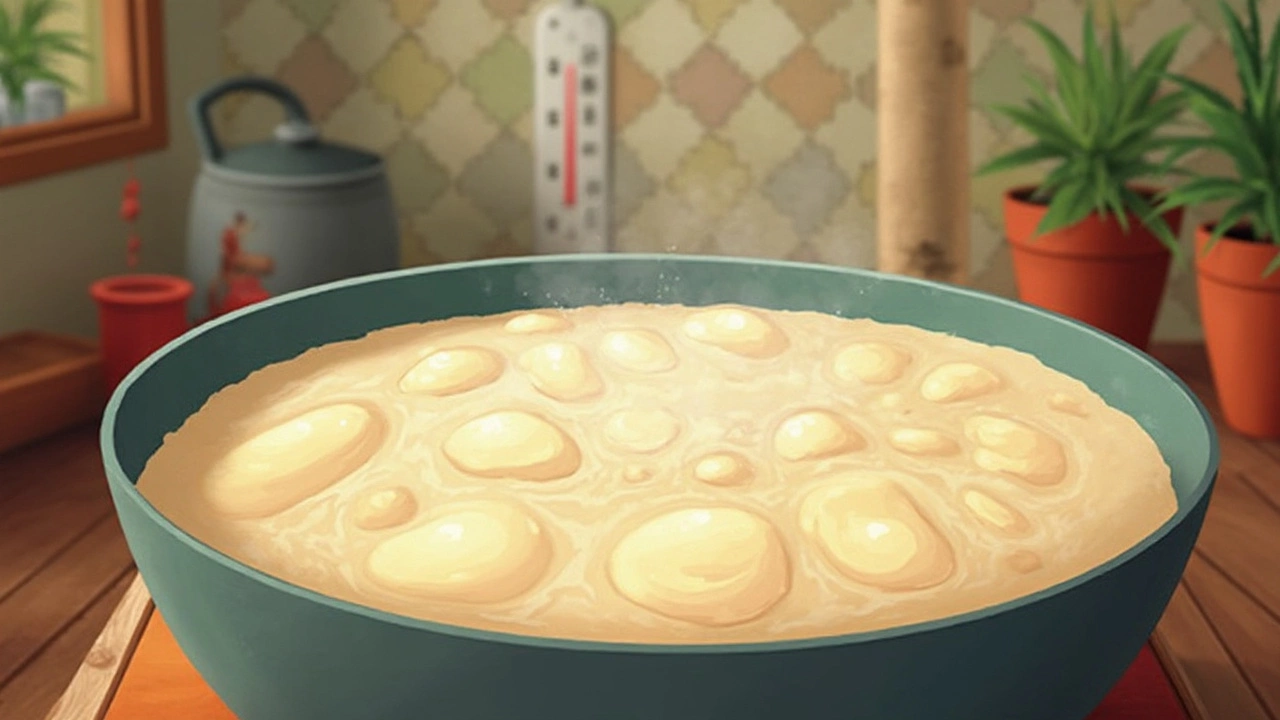Quick Dosa Batter Fermentation without Yeast: Easy Tips & Tricks
 Feb, 13 2025
Feb, 13 2025
Cooking perfect dosas often boils down to the fermentation of the batter. But let's be real, no one likes waiting around for hours to get that perfect blend. Good news is, you don't have to rely on yeast or endless patience. Let me share how you can speed things up like a pro.
First things first—temperature matters. Placing your batter in a warm spot, like inside an oven with just the light on, can do wonders. It's all about creating a cozy environment that's a bit warmer than room temperature. If you've got a thermometer, 30-35°C is the sweet spot.
You can also add a little sugar. Yeah, sounds like a weird trick, but a teaspoon does magic. It acts like a catalyst, giving those natural microbes a sugar rush that speeds up fermentation without affecting the taste.
- Understanding the Basics of Dosa Fermentation
- Techniques to Speed Up Fermentation
- Alternative Ingredients for Fermentation
- Troubleshooting Common Issues
Understanding the Basics of Dosa Fermentation
Getting the perfect dosa batter means nailing the quick fermentation process. This involves creating an environment where natural bacteria can thrive and do their thing. Without getting too science-y, it's about balancing rice and lentils mixed with water to create a chemical reaction that transforms your batter into a fluffy masterpiece.
Let's talk ratios. A common blend that many swear by is 3 parts rice to 1 part urad dal, or split black gram. But what's crucial is that both are soaked separately before blending. This simple step, often overlooked, can transform your fermentation journey.
"The art of making a good dosa goes beyond just ingredients—it's about intuition and timing," says renowned chef Sanjeev Kapoor. "Understanding fermentation is like holding the key to your culinary success."
Dosa batter needs a warm, humid climate to start bubbling and expanding, which indicates active fermentation is underway. In cooler climates, people sometimes find it tricky to achieve this process. Ever thought about using your home's heating vent or warm kitchen corner during winters? These solutions are often simple but effective.
Now, a wild fact: when done right, a fully fermented batter can double its volume within 8-12 hours at the right temperature, say around 30°C. If your kitchen thermometer shows it's cooler, you'll want to keep your batter out for a tad longer.
Essential Factors for Fermentation
- Water Quality: Use purified or boiled cooled water. Tap water rich in chlorine can disrupt natural fermentation.
- Grinding Time: Grind to the right consistency. It should be smooth, not grainy. A wet grinder, if you have one, produces optimal texture.
- Resting Place: As mentioned, the best spots are warm and consistent in temperature. Avoid windy windows or places that are too drafty.
- Container Choice: Use a bowl with some breathing room. Fermentation releases gases, and you'll want to allow space for expansion.
Stay tuned as we dive into how to speed up this very process in more detail. Remember, a little tweak here and there can make a world of difference to your dosa game!
Techniques to Speed Up Fermentation
Making dosa batter ferment quickly isn't as hard as you might think. With a few shortcuts, you can get that batter bubbling and ready in no time. Here's how it's done.
1. Utilize Warm Environments
Warm spots are your friends here. As I mentioned earlier, placing your batter in the oven with just the light on—no heat—can mimic the tropical warmth. Alternatively, you could put it on top of your fridge where it's usually warmer than other spots in the kitchen. If you're using a dedicated space heater in the winter, let it sit nearby (just not too close!).
2. Add Sugar
By adding a teaspoon of sugar, you can give those natural microbes a boost by feeding them. This nothing-to-somethin' trick won't change the taste of your dosa but helps in making the fermentation quick and efficient.
3. Mixing In Leftover Batter
Got some old dosa batter leftovers? Mix a bit into your new batch. The previous batch contains active cultures that can kickstart fermentation in the fresh mix.
4. Invest in a Yogurt
A bit of yogurt, like a tablespoonful, can help get things moving, thanks to its live cultures. This works especially well if your room temperature is a bit chilly, acting as a fermentation booster shot.
| Method | Effectiveness | Time Reduction |
|---|---|---|
| Warm Environment | High | 30-40% |
| Sugar Addition | Medium | 25-30% |
| Leftover Batter | High | 40-50% |
| Yogurt | Medium | 20-25% |
Each of these methods can turn the often long wait into something more manageable, letting you enjoy delicious dosas without the slow turmoil of time. Try out one or a combination to see what's speedy for you!

Alternative Ingredients for Fermentation
Sometimes, waiting for natural processes just isn't on the menu. You've got places to be and dosas to make. So, let's talk hacks—specifically, ingredients that can boost fermentation speed without introducing yeast.
Using Poha (Flattened Rice)
Poha is your unsung hero in the quest for quick dosa batter fermentation. Adding a small handful acts like magic. Thanks to its partial fermentation during processing, it brings active cultures to the table.
- Slightly rinse about 1/4 cup of poha.
- Blend it with your regular rice while still dry.
- Proceed with your usual recipe. Result? Speedy fermentation and a soft dosa.
Adding Fenugreek Seeds
Fenugreek seeds, or 'methi', might just be those tiny, powerful allies in disguise. Adding a teaspoon per cup of rice when soaking can do wonders.
- Soak a few seeds with your rice at the start.
- The seeds naturally encourage the growth of helpful bacteria.
- Not only does it boost fermentation, but it also adds a nice flavor depth.
Sour Buttermilk Magic
If you're really in a rush, how about a dairy twist? Sour buttermilk is great because it's already a fermented product.
- Mix a cup of sour buttermilk with your batter.
- Stir it in and let it rest in a warm place.
- Check after a couple of hours for that light, fluffy texture.
These alternatives not only help in speeding up the process but also give you a chance to experiment with flavors. Plus, they're natural, so you're keeping it healthy and real. Who knew dosa batter innovation could be this simple?
Troubleshooting Common Issues
Getting a perfectly fermented dosa batter isn't always a walk in the park. Sometimes things can go a bit off track. But no worries, most hiccups have simple fixes. Let's tackle the most common problems and how you can fix them.
Batter Not Rising Enough
If your dosa batter is just sitting there, refusing to rise, the microbes might not be getting enough warmth. Double-check that spot where you placed it. If needed, move the batter to a warmer area or wrap it in a blanket for a temperature boost. Also, too much water can dilute the batter, making it hard for fermentation to kick in. Maintain a thick paste consistency for best results.
Sour Batter
You did everything right, but why does it taste like a lemon? Over-fermentation is usually the villain here, often caused by too much warmth or resting it for too long. Next time, reduce the fermentation time or bring it back to room temperature earlier.
Thick or Runny Consistency
No one wants a dosa that’s either a soft pancake or like tissue paper. If it's too thick, adding a little water—gradually—and mixing can help. If it's runny, you might need to add a bit more flour and give it a good stir.
Bubbles Not Forming
The moment of the cook, and no bubbles in sight? Without those bubbles, your dosa won’t turn out crispy and light. This could be due to insufficient fermentation or too cold of a storage condition. Check your fermentation process and adjust temperature and time accordingly.
Here's a simple guide:
| Issue | Possible Cause | Solution |
|---|---|---|
| Not Rising | Cold environment | Find a warmer spot, like an oven with the light on |
| Sour Taste | Over-fermentation | Reduce fermentation time |
| Thick Consistency | Not enough water | Add water gradually |
| Bubbles Not Forming | Under-fermentation | Adjust temperature and time for better fermentation |
With these tips, you'll be handling dosa batter issues like a pro. Every blip is a stepping stone to those picture-perfect dosas, so keep tweaking and enjoying the process!